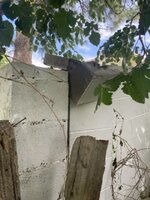Yes, IF a live line is laying on your car, the safest place for you is still inside the car. BUT, if the tires were to go flat or blow from damage, you no longer have that insulating factor as much. You can look up many unfortunate real-life examples, where a person tried to get out of their car and walk away, and is killed by shock immediately. As long as that powerlines is laying on the ground as well, you are dealing with power dissipating into the ground creating a ring of Step potential hazards.. Powerline systems have many safety devices built into them, such as fuses, reclosers and substation fault detection that look for an imbalance and shut the line down immediately. But I have seen a 3 phase line buried 50ft deep in an avalanche, with the pole entirely broken and snapped off and carried across a river, where the line was still fully active, because the snow is an insulating factor and the line never broke, so the protective devices that are much further away, never saw enough of an imbalance to kick in. That one was an interesting one to fix, took us all night and then some to come out with a solution to get through the winter





